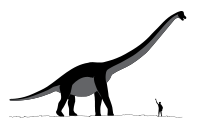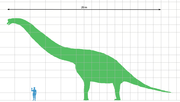
Sauroposeidon
Did you know...
This content from Wikipedia has been selected by SOS Children for suitability in schools around the world. Before you decide about sponsoring a child, why not learn about different sponsorship charities first?
| Sauroposeidon Temporal range: Early Cretaceous |
|
|---|---|
 |
|
| Scientific classification | |
| Kingdom: | Animalia |
| Phylum: | Chordata |
| Class: | Sauropsida |
| Superorder: | Dinosauria |
| Order: | Saurischia |
| Suborder: | Sauropodomorpha |
| Infraorder: | Sauropoda |
| Family: | Brachiosauridae |
| Genus: | Sauroposeidon Wedel et al, 2000 |
| Species | |
|
|
Sauroposeidon (SAWR-o-po-SIE-don), meaning "lizard- Poseidon", is a genus of sauropod dinosaur from the Early Cretaceous Period, related to the more famous Brachiosaurus. The only specimen to date is represented by four neck vertebrae. It was the tallest dinosaur known, estimated at 17 m (55.7 ft) high, and was around 30 meters (98 feet) long.
Discovery
The vertebrae were discovered in rural Oklahoma, not far from the Texas border, in a claystone outcrop that dates the fossils to about 110 million years ago ( mya). This falls within the Early Cretaceous Period, specificially between the Aptian and Albian epochs.
The four neck vertebrae were discovered in 1994 at the Antlers Formation in Atoka County, Oklahoma by Dr. Richard Cifelli and a team from the Oklahoma Museum of Natural History. Initially the fossils were believed to be simply too large to be the remains of an animal, and due to the state of preservation, believed to be tree trunks. In fact, they are the longest of any such bones known in dinosaurs, reaching lengths of 10 feet long apiece.
Thus, the vertebrae were stored until 1999, when Dr. Cifelli gave them to a graduate student, Matt Wedel, to analyze as part of a project. Upon their realization of the find's significance, they issued a press release in October of 1999, followed by official publication of their findings in the Journal of Vertebrate Paleontology in March of 2000. The new species was dubbed S. proteles, and the holotype is OMNH 53062.
Etymology
The generic name comes from sauros (Greek for "lizard"), and Poseidon, a sea-god in Greek mythology, who is also associated with earthquakes, that facet styled as Ennosigaios or Enisokhthōn, "Earthshaker". This is a reference to the notion that a sauropod's weight was so great that the ground shook as it walked (compare Brontosaurus, Seismosaurus, Suuwassea and Antetonitrus). The recently described Xenoposeidon's generic name follows suit.
The specific descriptor proteles also comes from the Ancient Greek and means "perfect before the end", which refers to Sauroposeidon's status as the last and most specialized giant sauropod known in North America, during the Early Cretaceous.
Size
- "It's truly astonishing. It's arguably the largest creature ever to walk the earth."
- — Richard Cifelli, discoverer of Sauroposeidon
The press release in 1999 immediately garnered international media attention, which led to many (inaccurate) news reports of "the largest dinosaur ever!". While it is true that Sauroposeidon is probably the tallest known dinosaur, it is neither the longest nor the most massive. Argentinosaurus is a better candidate for the title "World's Largest Dinosaur", though weak fossil evidence makes an exact ranking impossible.
The Sauroposeidon find was composed of four articulated, mid-cervical vertebrae (numbers 5 to 8), with the cervical ribs in place. The vertebrae are extremely elongated, with the largest one about 1.2 meters (4 feet) long, which makes it the longest on record. Examination of the bones revealed that they are honeycombed with tiny air cells, and are very thin, like the bones of a chicken or an ostrich, making the neck lighter and easier to lift.
Estimates of size are based on a comparison between the four Sauroposeidon vertebrae and the vertebrae of the HM SII specimen of Brachiosaurus brancai, located in the Humboldt Museum in Berlin. The HM SII is the most complete brachiosaur known, though since it is composed of pieces from different individuals its proportions may not be totally accurate. Comparisons to the other brachiosaurid relatives of Sauroposeidon are difficult due to limited remains.
The neck length of Sauroposeidon is estimated at 11.25 to 12 meters, compared to a neck length of 9 meters (30 ft) for the HM SII Brachiosaurus. This is based on the assumption that the rest of the neck has the same proportions as Brachiosaurus, which is a reasonably good conjecture.
Sauroposeidon was probably able to raise its head 17 meters (55.7 ft) above the ground, which is as high as a six-story building. The long neck and the high brachiosaurid shoulders are what makes it the tallest known dinosaur. In some ways, its build is similar to the modern giraffe, with a short body and an extremely long neck. In comparison, Brachiosaurus could probably raise its head 13.5 meters (44.2 ft) into the air.
Sauroposeidon's shoulders were probably 7 meters off the ground. Its estimated length is just under 30 meters (98 ft).
The mass of Sauroposeidon is estimated at 50 to 60 metric tonnes (55 to 65 tons). While the vertebrae of Sauroposeidon are 25–33% longer than Brachiosaurus's, they are only 10–15% larger in diameter. This means that while Sauroposeidon probably has a larger body than Brachiosaurus its body is smaller in comparison to the size of its neck, so it did not weigh as much as a scaled-up Brachiosaurus. By comparison, Brachiosaurus might have weighed 36 to 40 tonnes (40 to 44 tons). This estimate of the Brachiosaurus is an average of several different methodologies.
However, Sauroposeidon has a relatively gracile neck compared to Brachiosaurus. If the rest of the body turns out to be similarly slender, the mass estimate may be too high. This could be similar to the way the relatively robust Apatosaurus weighs far more than the longer but much slimmer Diplodocus. In addition, it is possible that sauropods may have an air sac system, like those in birds, which could reduce all sauropod mass estimates by 20% or more.
Environment
- "Sauroposeidon was an unexpected discovery, because it was a huge, gas-guzzling barge of an animal in an age of subcompact sauropods."
- —Matt Wedel, Sauroposeidon team leader
Sauroposeidon may be the last of the giant North American sauropods. Sauropods, which include the largest terrestrial animals of all time, were a very wide ranging and successful group. They first appeared in the Early Jurassic and it wasn't long before they spread across the world. By the time of the late Jurassic, North America and Africa were dominated by the diplodocids and brachiosaurids and, by the end of the Late Cretaceous, titanosaurids were widespread (though only in the southern hemisphere). Between these periods, in the Early Cretaceous, the fossil record is sparse. Few specimens have been found in North America from that time and those specimens that do exist are often fragmentary or represent juvenile members of their species. Most of the surviving sauropods at the time were also shrinking in size (to a mere 15 m, or 50 ft, in length, and maybe 10 to 15 tons or tonnes), which makes the discovery of an extremely specialized super-giant like Sauroposeidon very unusual.
Sauroposeidon lived on the shores of the Gulf of Mexico, which ran through Oklahoma at that time, in a vast river delta, similar to the Mississippi delta today. There were probably no predators who could take down a full-grown Sauroposeidon but juveniles were likely prey to Acrocanthosaurus (a carnosaur a little smaller than a T. rex) and to 'packs' of Deinonychus.
A giant brachiosaurid, similar to Sauroposeidon, was described in 2004 by Darren Naish and colleagues and is from the Early Cretaceous period of England. Known only from two neck vertebrae, it was apparently similar in some details to Sauroposeidon and perhaps similar in size. Its discovery highlights the similarity seen between Early Cretaceous North American and European dinosaurs.

